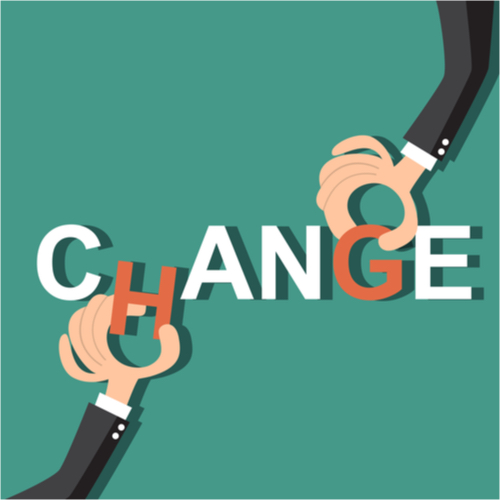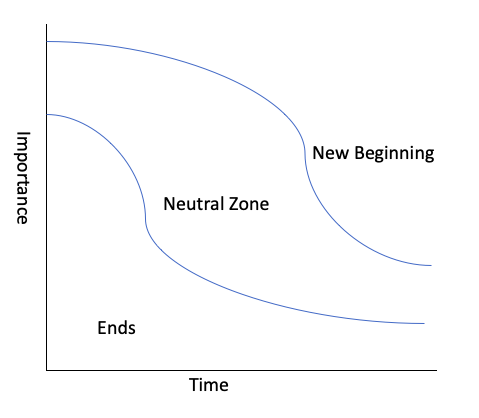
In this post, we’re going to be looking at the Bridges Transition Model which is a great change management tool that provides a focus on the transition that takes place during the different phases of change.
Modern business is characterized by change, which can occur for a variety of reasons.
From large scale change like business mergers or acquisitions through to smaller scale change such as new products/customers being introduced or process/procedural development.
For change to be successful, a business needs to employ structured processes and methods in order to embed the new and transition from the old.
This transition can be difficult, having as much (if not more) to do with people, and the emotional reaction generated than to the physical change itself.
Why businesses go through change
Change is ever-present and there can be any number of drivers.
Example include:
- Globalization
- Innovation
- Legislation (e.g Health & Safety).
- Mergers/Aquisitions
- New markets
- New skills
- Financial
In order to adapt, businesses need the appropriate tools and methodologies to drive change smoothly with minimal upheaval achieving the new state (and benefits) swiftly. Succesful companies will look to deploy change in a way that drives acceptance and support from it’s employees.
When businesses are faced with opposition to change the result is usually costly with impact to schedule.
If you’ve been part of a change program, you’ve probably noticed this yourself that the biggest challenge is people and their emotional response to change.
The Bridges Transition Model is a tool that provides method and structure on how to deal with this transition from one state to another, focussing specifically on the issue of people’s emotional response.
The Bridges Transition Model
This model was conceived by William Bridges (a change consultant) and published in 1991 in his book “Managing Transitions”. The model provides a structured approach to understanding people’s responses and their emotions as they go through the change process.
The model attempts to contrast change and transition. Bridges argued that change happens to people, where transition is the emotional reaction to change.
While Bridges model argues that transition is often the most challenging (especially where resistance occurrs), he used the model to demonstrate the opportunities for employees to be supporters rather than obstacles.
The model explores the reasons behind resistance and looks to use this information to leverage the process that delivers change.
Why is Bridges Transition Model important?
His model emphasizes that having a structured process, that pays appropriate recognition to the emotional state of its employees during the transition phase is a critical success factor in meeting change objectives,underpinned by understanding how individuals accepted change, letting go of what went before.
The model is not a structured process for change and is best used alongside other methodologies that focus on the change process.
The model aims to provide an understanding of people’s reactions to the different stages of change, enabling businesses to build appropriate action plans that take account of these steps.
Bridge Transition model Process
Bridges’ Transition Model utilizes a structure of three specific stages to demonstrate how people adapt to change.
- Ending
- The Neutral Zone.
- New Beginning.
The relationship between these phases, thier importance against implemetnation time can be seen below:

Bridge argued that the process of change is the same for everyone.
However, as you no doubt recognize from your own organization, everyone experiences change differently. People adapt at different speeds with some accepting change quicker than others.
Bridge, in his model, recognized three stages of transition.
1/ Ending
In transitioning from the current state, the change is proposed and the individual considers it, and the impact of leaving the current state behind.
The first stage in Bridge’s transition model is when:
- Employees believe change is occurring
- Employees establish what they might lose and look to limit these losses.
- Change is evident in working environments (both physical and in terms of processes)
- Employees often feel unsettled
Perhaps understandably, this phase can be challenging and often led by emotions and can be characterized by resistance.
Depending on the context and impact of change, businesses should look at providing appropriate levels of support and assistance to enable employees in understanding.
Much of the actions on the business during this stage is on communication (both ways). Structures need to be put in place that:
- Communicate the change, including the details of:
- Reasons behind the change
- What will change
- What will stay the same
- Any proposed benefits.
Remember that employees will usually have a fear of something that they don’t understand and so what’s key is to communicate, communicate and communicate!
The more you can inform them of the change process and the benefits the better.
The better the buy in the more likely they will support and help.
As well as placing particular emphasis on communication, the business also has a requirement to focus on those affected, which includes both expecting and respecting an emotional resoponse.
2/ Neutral Zone
The Bridges Transition Model’s next step in the transition process is the Neutral zone.
Bridge argued that this phase was the key to succesfull change but was the hardest step often characterised by struggle.
The Neutral Zone reflects the period of transition from the old to the new state.
This phase is characterised by impacts on staff as they see the outcome of the change.
Employees will be getting used to “new”. This may be new procedures, new teammates, new levels of work. Employees may see a change in psychology with people creating a new sense of identity associating with the change.
During this phase, people will be adapting at different speeds and it can often be characterized by confusion, insecurity, resentment as groups may emerge some supportive and others disruptive.
During this stage, the business will be required to:
- Communicate
- Capture and resolve issues
- Accept feedback (even negative feedback)
- Provide structured assistance/help
- Celebrate progress
3/ New Beginnings
The final stage in Bridges Transition model is that of New Beginnings.
With the intended change now fully embedded, this stage is characterized primarily by an acceptance of the new state.
By this stage, the change has been fully deployed and supported by the business (likely through training, organizational structure, funding etc.)
This stage also shows initial benefits of the change being delivered.
With these benefits, the employees can begin to understand the change fully, securing buy-in.
As such, during this stage, employees offer a different emotional response with a far more positive outlook.
During this phase, the business needs to consider:
- Demonstrating the benefits achieved and Celebrating the results
- Drive consistency and structure around the new state
- Continue to communicate
Summary
We hope you enjoyed this post on the Bridges Transition Model. As you can see it offers a different view on change.
Including the people response to change in planning may seem obvious but alas many business fail to grasp this which all too often results in conflict.
Planning around the 3 stages and looking to mitigate the issues described in the model is key if you are to tackle the likley issues raised with change.
Have you been affected by change in your organization? How has it impacted you? Do you recognize the three stages of the Bridge Transition Model? How has your business handled these? We’d love to hear from you and welcome feedback. Please feel free to utilize the comments section below or fire us a message on Twitter.
This post is part of our Management and Leadership Guide.